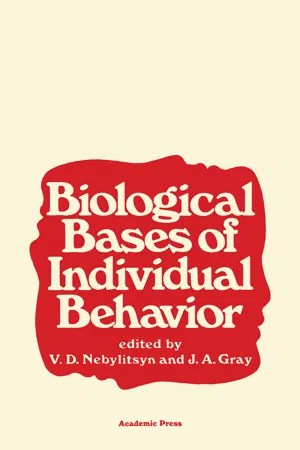
eBook - PDF
Biological Bases of Individual Behavior
- 460 pages
- English
- PDF
- Available on iOS & Android
eBook - PDF
Biological Bases of Individual Behavior
About this book
Biological Bases of Individual Behavior contains a mixture of papers from East and West. The book can be organized into two parts. The articles in the first part, which might broadly be termed ""physiological"", examine a number of questions relating to the physiological constitution and to methods of measuring the properties of the nervous system. This section opens with one of Teplov's last papers, which contains a lucid exposition of the main results of research carried out in 1964 in the laboratory he directed. The other articles in this section elucidate the use of electroencephalographic and Chronometrie methods of studying the properties of the nervous system; examine problems of sensitivity and ""partiality"" in the manifestation of the basic properties; and present the results of experiments conducted to study the correlations between certain properties of the nervous system and features of the human constitution, as well as between age and neurodynamic factors. The second part of the volume may be described as psychophysiological. It consists of articles which examine the possible physiological mechanisms of individual psychological features of behavior. Many are devoted to either experimental or theoretical analysis of the neurophysiological bases of the personality dimension of extraversi?n-introversion.
Frequently asked questions
Yes, you can cancel anytime from the Subscription tab in your account settings on the Perlego website. Your subscription will stay active until the end of your current billing period. Learn how to cancel your subscription.
At the moment all of our mobile-responsive ePub books are available to download via the app. Most of our PDFs are also available to download and we're working on making the final remaining ones downloadable now. Learn more here.
Perlego offers two plans: Essential and Complete
- Essential is ideal for learners and professionals who enjoy exploring a wide range of subjects. Access the Essential Library with 800,000+ trusted titles and best-sellers across business, personal growth, and the humanities. Includes unlimited reading time and Standard Read Aloud voice.
- Complete: Perfect for advanced learners and researchers needing full, unrestricted access. Unlock 1.4M+ books across hundreds of subjects, including academic and specialized titles. The Complete Plan also includes advanced features like Premium Read Aloud and Research Assistant.
We are an online textbook subscription service, where you can get access to an entire online library for less than the price of a single book per month. With over 1 million books across 1000+ topics, we’ve got you covered! Learn more here.
Look out for the read-aloud symbol on your next book to see if you can listen to it. The read-aloud tool reads text aloud for you, highlighting the text as it is being read. You can pause it, speed it up and slow it down. Learn more here.
Yes! You can use the Perlego app on both iOS or Android devices to read anytime, anywhere — even offline. Perfect for commutes or when you’re on the go.
Please note we cannot support devices running on iOS 13 and Android 7 or earlier. Learn more about using the app.
Please note we cannot support devices running on iOS 13 and Android 7 or earlier. Learn more about using the app.
Yes, you can access Biological Bases of Individual Behavior by V. D. Nebylitsyn, J. A. Gray, V. D. Nebylitsyn,J. A. Gray in PDF and/or ePUB format, as well as other popular books in Psicología & Psicología fisiológica. We have over one million books available in our catalogue for you to explore.
Information
Table of contents
- Front Cover
- Biological Bases of Individual Behavior
- Copyright Page
- Table of Contents
- List of Contributors
- English Editor's Preface
- Foreword
- Chapter 1. The Problem of Types of Human Higher Nervous Activity and Methods of Determining Them
- Chapter 2. The Driving Reaction as a Method of Study in Differential Psychophysiology
- Chapter 3. Concentration of Nervous Processes as an Individual Typological Feature of Higher Nervous Activity
- Chapter 4. Interanalyser Differences in the Sensitivity-Strength Parameter for Vision, Hearing and Cutaneous Modalities
- Chapter 5. The General and Partial Nervous System Types—Data and Theory
- Chapter 6. Problems of Interrelationship Between Typological Features and Age
- Chapter 7. The Correlation Between Background Alpha Activity and the Characteristics of the Components of Evoked Potentials
- Chapter 8. Cerebral Evoked Responses and Personality
- Chapter 9. Absolute Sensitivity of the Analysers and Somatotype in Man
- Chapter 10. The Interpretation of Pavlov's Typology, and the Arousal Concept, in Replicated Trait and State Factors
- Chapter 11. Human Typology, Higher Nervous Activity, and Factor Analysis
- Chapter 12. The Psychophysiological Nature of Introversión-Extraversion: A Modification of Eysenck's Theory
- Chapter 13. Conditioning, Introversion-Extraversion and the Strength of the Nervous System
- Chapter 14. The Theory of Individual DifFerences in Neo-Behaviourism and in the Typology of Higher Nervous Activity
- Chapter 15. A Note on the Criteria of Dynamism of the Nervous Processes
- Chapter 16. Experimental Pain
- Chapter 17 The Relationship of Strength-Sensitivity of the Visual System to Extraversion
- Chapter 18. Concerning the Relation Between Extraversion and the Strength of the Nervous System
- Chapter 19. Studies of Individual Differences at the Applied Psychology Unit
- Chapter 20. Alterations in Functional State as affected by Different Kinds of Activity and Strength of the Nervous System
- Chapter 21. Vigilance as a Function of Strength of the Nervous System
- Chapter 22. Study of the Correlation between Flexibility of Attention and Dynamism of Nervous Processes
- Chapter 23. Influence of Neuro-Dynamic Factors on Individual Characteristics of Problem Solving
- Chapter 24. Crime and Personality: A Review of Eysenck's Theory
- Chapter 25. Learning Theory, the Conceptual Nervous System and Personality
- Chapter 26. The Problem of General and Partial Properties of the Nervous System
- Author Index
- Subject Index